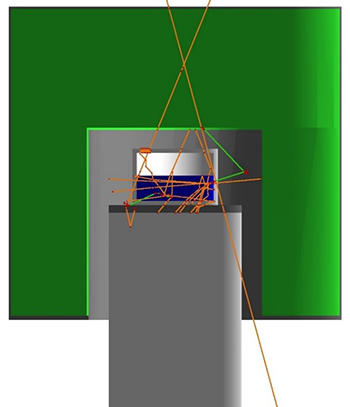Summary
Primary activity standards for radionuclides form the foundation for the many products and services of the Radioactivity Group and serve as ground-truth for determining fundamental properties of radionuclides. Primary standardization of a given radionuclide is essentially a realization of the International System of units (SI) that does not rely on a previous Bq realization of the same radionuclide. NIST develops and implements multiple methods of primary standardization appropriate for the wide variety of radionuclides and their decay types needed in the US and around the world.
Description

Monte-Carlo simulation of NIST live-timed anticoincidence system. Simulation and experiment are combined to achieve high accuracy in the primary standardization of electron capture radionuclides.
As the National Metrology Institute (NMI) for the US, NIST is responsible for realizing the SI units. The derived SI unit for activity of a radionuclide is the becquerel, Bq. NIST has a proud history of contributing to the development of new and improved primary standardization methods for the Bq to meet evolving US needs.
Presently, the predominant primary standardization methods at NIST are liquid-scintillation based. Liquid scintillation is a nearly universal measurement platform since most radionuclides can be incorporated into a liquid scintillation cocktail, which provides a 4π geometry for detecting radioactive decay products. The exact variant of liquid scintillation counting used for primary standardization depends on the properties of the radionuclide. For gamma-ray emitting radionuclides, coincidence techniques can be used to determine the activity without needing to know the detector efficiency. For pure beta decay or mixed decays, the triple to double coincidence ratio (TDCR) and CIEMAT-NIST efficiency tracing methods are applied, both of which use ratios of measurements to produce robust measurement results.
Radioactive gases require dedicated methods such as internal gas counting using a set of length-compensated counters and quantitative gas transfer methods. We are presently building a gas counting capability, with a focus on noble gases, tritium, and carbon-14, with an eventual goal to provide standards and calibrations services for nuclear power and medicine customers.
In 2021, NIST began a new Innovations in Measurement Science (IMS) project called True Bq, to realize the Bq by Decay Energy Spectrometry (DES) using superconducting Transition Edge Sensors (TESs). The goal of this ambitious project is to enable users to realize the Bq not only for single radionuclides, but for mixtures of multiple radionuclides and with quantitative source preparation. In 2025, this method was used for the first time as a primary standardization of a multi-nuclide sample - as part of the Am-243 Standard Reference Material certification.
For all these methods, detailed detector modelling is becoming especially important and is being developed at NIST using Monte Carlo radiation transport and interaction methods. These models are important for uncertainty analysis and understanding the effects of impurities.
The primary standards project relies on multiple capabilities within the radioactivity group. The methods described here require knowledge of which radionuclides are present in a sample. This is achieved through gamma-ray spectrometry and sometimes alpha or mass spectrometry. In addition, specialized radiochemistry and source preparation techniques are required when developing a standard for a new radionuclide.
An important activity within the Primary Standards project is participation and leadership in international measurement comparisons for radioactivity. Multilateral Key Comparisons are organized by the Consultative Committee on Ionizing Radiation (CCRI) of the BIPM, of which NIST is a member and holds multiple leadership roles. Such comparisons provide an opportunity to demonstrate equivalence of radioactivity standards among participants, in support of international commerce. Comparisons results can be found here: https://www.bipm.org/kcdb/. NIST frequently organizes and participates in informal comparisons and collaborations as well to test new capabilities and to combine results with other laboratories when researching the properties of radionuclides.

